Professor, Artist Marlene Jack Retires from Department
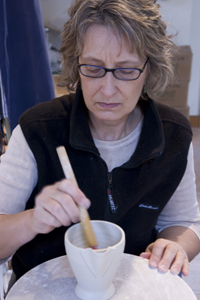 When Marlene Jack arrived on campus in 1974, she had an MFA in ceramics from the University of Minnesota. And she had a mission.
When Marlene Jack arrived on campus in 1974, she had an MFA in ceramics from the University of Minnesota. And she had a mission.
“The ceramics program lived in a small, windowless, cinderblock room in Andrews Hall,” recalls Professor Jack. “And the gas-fired kilns were in the parking lot next to the loading dock. It was far from ideal.”
After many conversations with the College's administration, Jack eventually landed the "old power plant building" and $5,000 to adapt the structure and move the program in. Then, brick by brick, she and students in her ceramics class relocated and rebuilt the kilns—in the same spot they stand today. The students also built the storage racks and other studio necessities. 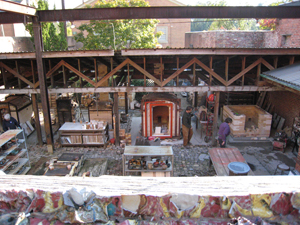
“With the new space came new opportunities,” says Professor Jack. “Over time we added new equipment, some of which, such as a large slab roller and extruder, allowed students to expand their creative options for working in the material. We were also able to isolate activities such as clay mixing to a more contained space, and we could build different types of kilns to offer varied options for firing student work.”
Through the years, the ceramics studio slowly evolved, adding a loft, a deck area in the back room, and a roof across the yard to protect the kilns from the weather. But Jack is quick to point out that the best thing about the studio is the atmosphere.
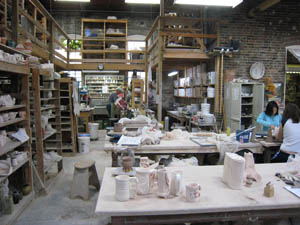 “The exposed brick walls and open two-story ceiling create an inspiring space in which to work,” says Professor Jack. “On shelves around the studio sit the collection of pieces left behind by all the visiting artists we’ve had here over the past 30 years, a visual library for the students to take down and study. But there is also an atmosphere of camaraderie and trust that grows each semester between the students using the studio.”
“The exposed brick walls and open two-story ceiling create an inspiring space in which to work,” says Professor Jack. “On shelves around the studio sit the collection of pieces left behind by all the visiting artists we’ve had here over the past 30 years, a visual library for the students to take down and study. But there is also an atmosphere of camaraderie and trust that grows each semester between the students using the studio.”
In the early 1980s Professor Jack helped to establish a visiting artists program for ceramics, which brings clay artists to the College to conduct workshops and share their expertise, philosophy, and stories as artists. In the spring and fall semesters, ceramics students and faculty host a campus sale of their works to help fund the program.
“The visiting artist workshops enabled me to enrich and broaden the scope of the clay program,” says Professor Jack. “And some of the younger emerging artists have been good role models for students, showing them how they have managed to carve out a life in clay, not only with higher academic degrees but also through apprenticeships, residencies, and other ceramics-related endeavors.”
Over time, teaching has become an integral part of her development as an artist, says Professor Jack. “In the classroom, verbalizing methods of working to students brought greater clarity to my own thoughts, while in turn a student’s fresh, intuitive approach challenged my preconceptions of the material.”
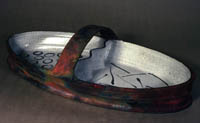 “What I learned through my own creative work, I was able to bring to my teaching. And I always learned from my students. I can remember certain students over the years whose ideas and skills were evolving so rapidly that I could hardly wait to see what they would show me next.”
“What I learned through my own creative work, I was able to bring to my teaching. And I always learned from my students. I can remember certain students over the years whose ideas and skills were evolving so rapidly that I could hardly wait to see what they would show me next.”
As an artist-scholar, Professor Jack's work has been firmly rooted in the ideas and aesthetics of functional ceramics, in particular Japanese folk pottery with its emphasis on a less is more artistic philosophy.
“I strive for simplicity of form with a minimum of embellishment, and constantly question the right balance between the two,” she says. “Form is my first priority, and I instinctively use architecture as my reference for the underlying structural framework.”
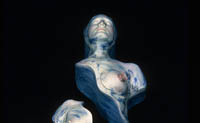 In the late 1980s she began a decade-long departure from her usual work, creating a series of figurative sculptures. The sculptures were generated from life-sized plaster molds and used clay and mixed media. Over time, this series evolved toward more modest and intimate scale figures placed in architectural settings.
In the late 1980s she began a decade-long departure from her usual work, creating a series of figurative sculptures. The sculptures were generated from life-sized plaster molds and used clay and mixed media. Over time, this series evolved toward more modest and intimate scale figures placed in architectural settings.
Through this largely autobiographical series, Professor Jack communicated ideas related to the human condition, particularly concepts centered on fear, luck, loss, and time.
“What I wanted to say in my work at the time, I couldn’t say through functional pots,” says Professor Jack. “A sculptural approach opened a door of opportunity to move in a direction I might not otherwise have explored.”
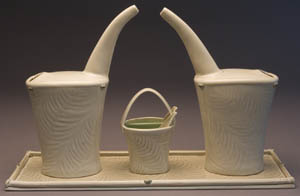 Today, having progressed through different subjects and methods of working, her focus is now where her roots have always been, on function.
Today, having progressed through different subjects and methods of working, her focus is now where her roots have always been, on function.
“My pots are about touch and use, the life of the kitchen and the pleasures of the table,” she says. “They are about the potential to enrich and awaken the routines and rhythms of our daily environment and bring art, beauty, and intelligence to our daily private lives.”
 Skip to main content
Skip to main content

